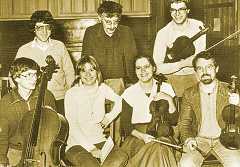Air of another planet
A quarter century of musical conviction
The Schoenberg Quartet celebrates a milestone
Niek Nelissen
Four string players in an ensemble
 The founding of the Schoenberg Ensemble reflected the then increasing interest in formations that were smaller and more flexible than those constituted by the symphony orchestras. Other examples included De Volharding, established in 1972 by Louis Andriessen, and the ASKO Ensemble, a product of the Amsterdam Student Chamber Orchestra. The Schoenberg Ensemble could be expanded according to the demands of the repertoire, one in which the composers of the Second Viennese School occupied a focal position. In 1976, with just three string players (violinist Janneke van der Meer, viola player Henk Guittart and cellist Hans Woudenberg), the need arose for a second violinist. The obvious choice was Wim de Jong, whom the members of the group had known for some time. His addition meant that the ensemble now possessed a string quartet.
The founding of the Schoenberg Ensemble reflected the then increasing interest in formations that were smaller and more flexible than those constituted by the symphony orchestras. Other examples included De Volharding, established in 1972 by Louis Andriessen, and the ASKO Ensemble, a product of the Amsterdam Student Chamber Orchestra. The Schoenberg Ensemble could be expanded according to the demands of the repertoire, one in which the composers of the Second Viennese School occupied a focal position. In 1976, with just three string players (violinist Janneke van der Meer, viola player Henk Guittart and cellist Hans Woudenberg), the need arose for a second violinist. The obvious choice was Wim de Jong, whom the members of the group had known for some time. His addition meant that the ensemble now possessed a string quartet.
The quartet gave its first performance, dubbed Ein Abend in Wien, on November 21st 1976 in the Recital Hall of Groningen’s Oosterpoort complex. Not only the title but also the structure of the programme was so characteristic of the ensemble at the time that the matter deserves closer attention. The four strings opened the concert with Webern’s Rondo, composed in 1906, and the Langsamer Satz, written one year previously. This was followed by the same composer’s Sechs Lieder op. 14, with the soprano Wendela Bronsgeest. The strings then played Schoenberg’s Die eiserne Brigade, with Fred Oldenburg at the piano. The first half concluded with Johann Strauss’s well-known waltz Rosen aus dem Süden in Schoenberg’s arrangement for the Verein für musikalische Privataufführungen, with Reinbert de Leeuw at the harmonium. Following the intermission the ensemble played Schoenberg’s Suite op. 29, its showpiece at that time. Ten musicians took part in the concert.
An illustration of how close the ties were within the ensemble is the fact that every one of the four string players was supplemented by a family member. The string quartet itself comprised a brother-sister pair (Janneke van der Meer and Henk Guittart), while Hans Woudenberg’s brother Pierre Woudenberg played clarinet. Liesbeth de Jong, the wife of Wim de Jong, played bass clarinet. Internal friendships further underscored the intimate bonds within the group. The Nieuwsblad van het Noorden was full of praise for the ensemble’s members, bestowing on it the accolade ‘outstanding instrumentalists’. Neither the reviewer Renske Koning nor Ein Abend in Wien’s approximately two-hundred-strong audience will have realised that this performance was an historic occasion: the Schoenberg Quartet marks that Sunday in Groningen as its anniversary.
There is a case against the legitimacy of this anniversary: the four string players certainly did not have the feeling they formed a string quartet. On the contrary, they felt they were first and foremost members of the Schoenberg Ensemble, which performed in a great variety of formations. Moreover, the number of concerts during those early years that featured works for string quartets could be numbered on the fingers of one hand. In 1976 there was just that one occasion in Groningen. The following year, the four string players accompanied violinist Vera Beths in a Rondo by Schubert, repertoire not exactly representative of the Schoenberg Ensemble. Starting in 1978, programmes increasingly began to feature string quartets. Highlights of the Schoenberg Quartet’s early years include the world première in 1978 of Schoenberg’s Scherzo and, a year later, the first joint performance with the Netherlands Chamber Choir, in which the four string players played the Fourth String Quartet of Milhaud and Webern’s Opus Posthumous, composed in 1905.